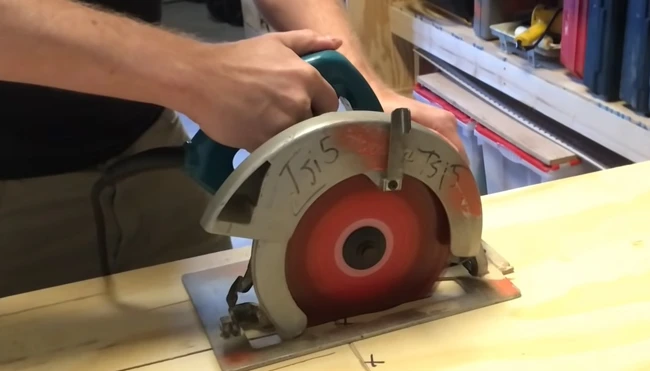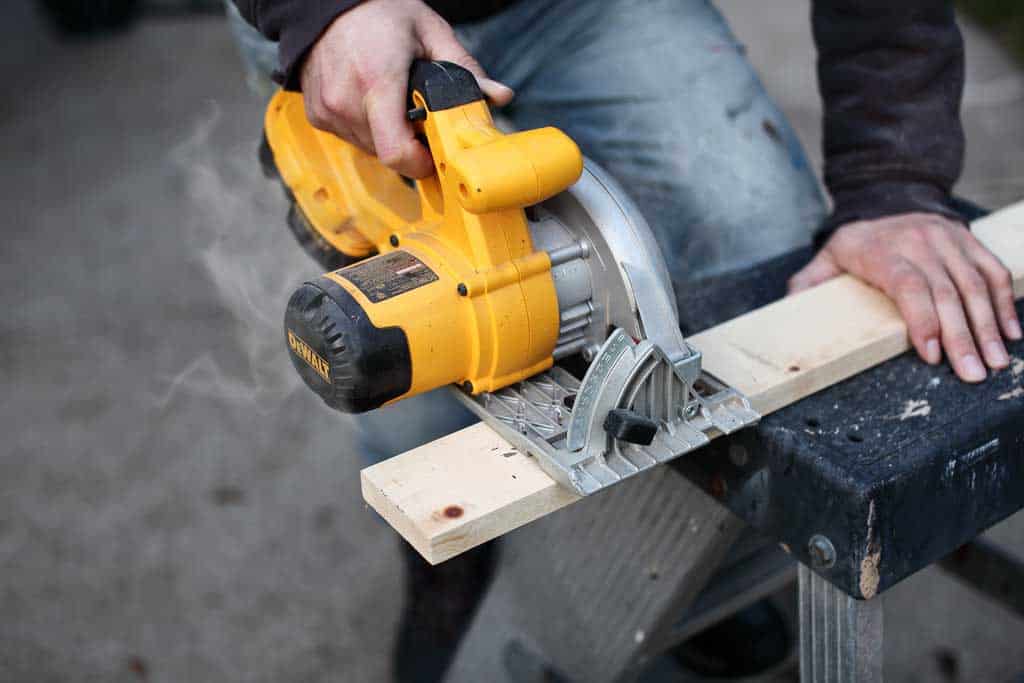Why is a circular saw smoking? Well, let’s dive in and find out! You may have noticed your trusty circular saw puffing out some smoke, and you’re probably wondering what’s causing it. Don’t worry, we’ve got you covered with all the answers, my young DIY enthusiasts.
Now, imagine this: you’re in the middle of a woodworking project, making precise cuts, and suddenly, smoke starts billowing out of your circular saw. It may seem alarming, but there’s often a logical explanation behind this smoky situation. Stick around as we unravel the mystery and understand why your circular saw might be smoking.
So, grab your safety glasses and stay tuned because we’re about to tackle the topic of why circular saws can smoke. Exciting, right? Let’s get started and demystify this smoky issue once and for all!
Is your circular saw smoking and you’re not sure why? Find out the possible reasons behind this issue and what you can do to fix it. From a dull blade to an overheated motor, several factors can cause a circular saw to smoke. Learn how to troubleshoot and resolve these problems to keep your tool in top shape. Don’t let a smoking circular saw dampen your DIY spirit!

Why is Your Circular Saw Smoking?
There’s nothing more frustrating than starting up your circular saw only to see smoke billowing out. Not only is it a safety concern, but it also indicates that there may be a problem with your tool. In this article, we’ll explore the potential reasons why your circular saw is smoking, providing you with valuable insights to help troubleshoot the issue and keep your saw in optimal condition. From blade issues to motor problems, we’ll cover it all. Keep reading to discover the common culprits behind a smoking circular saw.
Common Causes of Smoke in a Circular Saw
Blade Issues: One of the most frequent causes of a smoking circular saw is a dull or damaged blade. When a blade is dull, it can overheat and generate friction, leading to smoke. Additionally, if the blade is bent or damaged, it can cause the saw to become off-balance, resulting in excessive heat and smoke. To prevent this, ensure you are using a sharp and properly aligned blade, and replace it if necessary.
Motor Problems: Another reason your circular saw may produce smoke is motor-related issues. If your saw’s motor is overloaded or working harder than it should, it can generate excessive heat and smoke. This can occur if you are pushing the saw too hard or if the motor has become worn out over time. To avoid motor-related smoking, make sure you are not exerting too much pressure on the saw and consider getting your motor checked by a professional.
Electrical Problems: Faulty electrical connections can also be a potential cause of smoke in your circular saw. If there is a loose or damaged wire, it can create resistance and heat, resulting in smoke. It is crucial to regularly inspect your saw’s power cord and plugs for any signs of wear or damage. If you notice any issues, it is best to have them repaired or replaced by a qualified electrician to avoid any potential safety hazards.
How to Address a Smoking Circular Saw
Blade Maintenance: To prevent blade-related smoking, always ensure your circular saw blade is sharp and clean. Regularly inspect the blade for any signs of damage, such as chips or bent teeth, and replace it if necessary. It is also essential to properly align the blade to ensure a smooth cutting experience and minimize friction and heat buildup.
Motor Care: Properly maintaining your circular saw’s motor can help reduce the risk of smoking. Avoid overloading the saw by applying excessive pressure or cutting materials that are beyond its capacity. If you notice any unusual noises or a decrease in performance, it is advisable to have the motor professionally inspected and serviced to prevent any further damage and potential smoking incidents.
Electrical Safety: To decrease the likelihood of smoke caused by electrical problems, always ensure that your saw’s power cord and plugs are in good condition. Avoid using an extension cord unless necessary and use one rated for the saw’s power requirements. Regularly inspect the cord for any signs of fraying or damage, and replace it immediately if needed. Additionally, it is crucial to keep your saw’s ventilation ports clean and free from debris to prevent heat buildup.
Conclusion
Identifying and addressing the causes of a smoking circular saw is essential for maintaining both the performance and the safety of your tool. By understanding the common culprits behind the smoke and implementing proper maintenance practices, you can ensure that your circular saw remains in optimal condition. Remember to always prioritize safety and consult a professional if you are unsure about any repairs or maintenance procedures. Keep your saw running smoothly and smoke-free!
Key Takeaways: Why is a Circular Saw Smoking?
– Smoking from a circular saw can be caused by various factors, such as a dull blade, improper use, or a damaged motor.
– Using a sharp blade and proper cutting technique can help prevent smoking.
– Overheating due to excessive use or friction can also cause smoking.
– It’s important to always wear safety gear and work in a well-ventilated area when using a circular saw.
– Regular maintenance and cleaning of the saw can help prevent smoking and prolong its lifespan.
Frequently Asked Questions
Welcome to our Frequently Asked Questions section, where we address common concerns about circular saw smoking. Check out the Q&A below to learn more about this issue and find the answers you’re looking for.
1. Why is my circular saw smoking?
There can be several reasons why your circular saw is smoking. One common cause is overheating, which can occur if you’ve been using the saw for an extended period without giving it time to cool down. Another possible reason is a dull or improperly installed blade, causing excessive friction and generating heat. Additionally, using the wrong type of blade for your specific cutting material can lead to smoking.
To troubleshoot this issue, start by checking the blade. Make sure it’s sharp, securely installed, and appropriate for the material you’re cutting. Also, check for any debris or sawdust buildup near the blade that may be obstructing airflow and causing the motor to overheat. If the problem persists, it’s advisable to consult a professional or contact the manufacturer for further assistance.
2. How can I prevent my circular saw from smoking?
Preventing your circular saw from smoking requires a few simple steps. First and foremost, ensure you’re using the appropriate blade for the specific material you’re cutting. This will minimize friction and reduce the chances of overheating. Regularly inspect the blade for signs of wear or damage, and replace it if necessary. Keeping the blade clean by removing sawdust and debris after each use also helps maintain proper functionality.
Additionally, it’s essential to give your saw breaks during extended use to prevent overheating. This allows the motor to cool down and minimizes the risk of smoking. Finally, always refer to the manufacturer’s instructions and guidelines for operating your circular saw. They provide valuable information on proper usage and maintenance that can help prevent smoking and ensure the longevity of your saw.
3. Can a smoking circular saw be dangerous?
A smoking circular saw can potentially be dangerous if not addressed promptly. Smoking usually indicates a problem with the tool, such as overheating or blade malfunction. If left unattended, these issues can escalate and cause further damage or even accidents. Overheating can lead to motor failure or even the risk of fire if not resolved.
Furthermore, a saw that smokes excessively may become difficult to control, compromising your safety and increasing the chances of accidents. It’s crucial always to prioritize safety and address any smoking issues with your circular saw immediately. If you’re unsure about how to resolve the problem or if the smoking continues despite troubleshooting, consider seeking professional assistance or contacting the manufacturer for guidance.
4. Is there a way to fix a smoking circular saw myself?
Fixing a smoking circular saw yourself is possible in some cases, but it depends on the cause of the smoking and your level of expertise. If the smoking is due to a dull blade, installing a new, sharp blade can often solve the problem. Similarly, if there are any obstructions near the blade, removing them can restore proper functioning. Cleaning the saw, ensuring proper ventilation, and allowing it to cool down can also help resolve smoking issues caused by overheating.
However, it’s vital to exercise caution when troubleshooting and fixing power tools. If you’re unsure of the cause or don’t have experience with saws, it’s advisable to seek professional assistance. They have the knowledge and expertise to diagnose and fix more complex issues, ensuring your circular saw is safe and functioning optimally.
5. When should I replace my circular saw if it’s smoking regularly?
If your circular saw continues to smoke regularly, even after troubleshooting and attempting to fix the issue, it may be time to consider replacing it. Persistent smoking can indicate underlying problems that may be difficult to resolve or indicative of serious damage to the saw. Continuing to use a faulty tool can compromise your safety and potentially result in further damage or accidents.
To determine if it’s time for a replacement, assess the overall condition of your saw. Consider factors such as its age, frequency of use, and any previous issues encountered. If the saw is old, has had a history of problems, or is no longer under warranty, it may be more cost-effective and safer to invest in a new saw. Always prioritize your safety and the proper functioning of your tools.

Saw Burn Marks? See How to Get Clean Saw Cuts in Wood
Summary
Here’s a wrap-up of why your circular saw might be smoking. Sometimes the blade is dull or the wood is too hard, which can cause friction and heat. The motor can also overheat if it’s overloaded or if the saw is running for too long without a break.
Additionally, using the wrong type of blade or improper handling can lead to smoking. It’s important to maintain and clean your saw regularly, and always follow safety guidelines to prevent accidents and damage. Remember, safety comes first!
